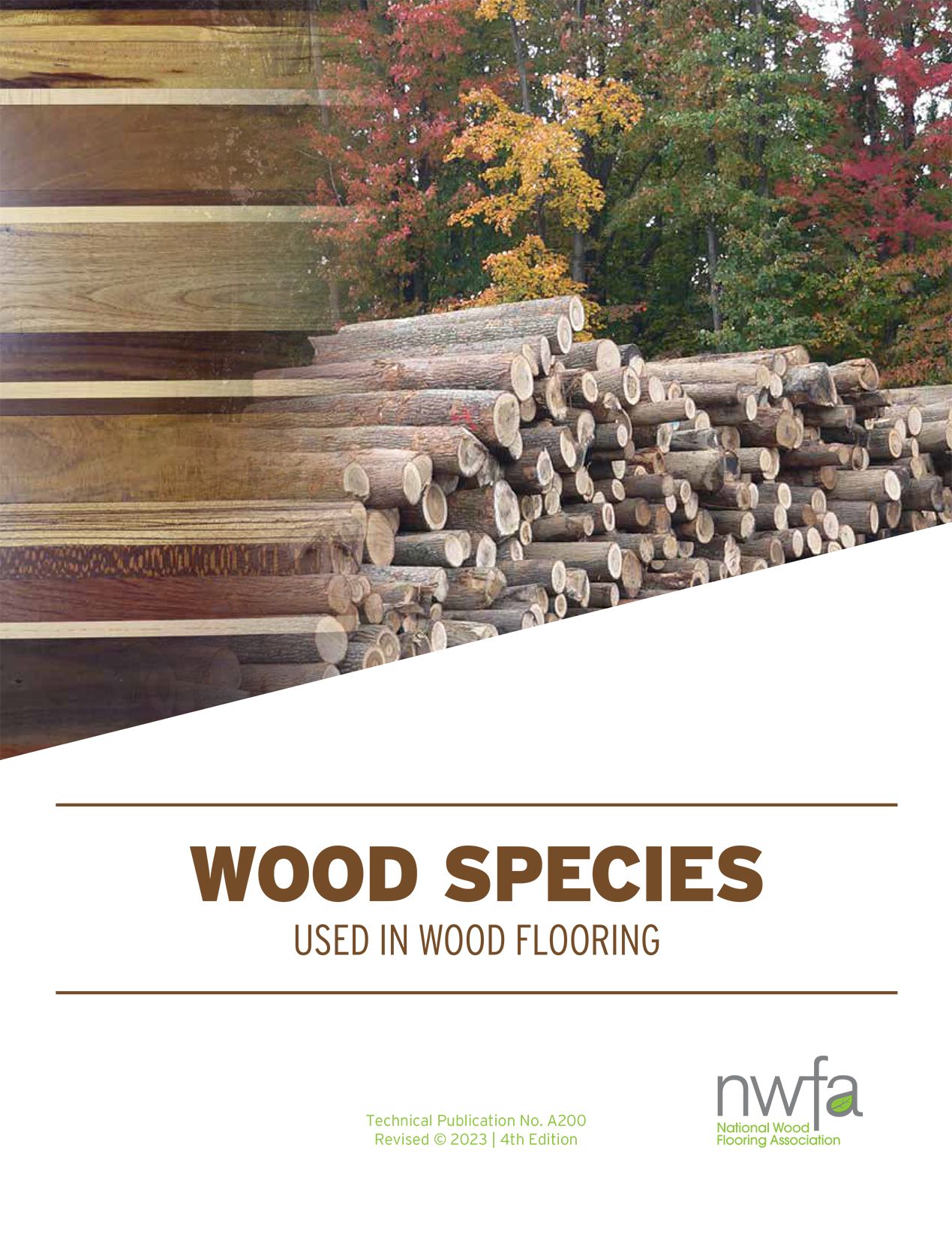Category focus: wood
NWFA Releases Updated Wood Species Technical Publication Focused on Domestic Wood and Sustainability
By Beth Miller


The wood flooring industry carries a considerable burden, but it is one that those who are passionate about wood are happy to bear. It must consider if a species has been legally sourced, whether it is sustainable, and list every single attribute of every species to ensure the application is appropriate for that type of wood. That does not happen in a vacuum. Instead, it takes a team of wood experts and manufacturers working over the course of years to perform this research in conjunction with outside agencies to produce a technical manual, listing everything needed to assist in the production of wood flooring and the flooring specification process. The National Wood Flooring Association (NWFA) Wood Species technical publication is the fruit of that labor.
“The Wood Species technical publication provides the critical foundational knowledge needed in the conversation between the architect, interior designer, builder, flooring contractor and homeowner when specifying the most appropriate species of wood flooring for a project,” said Charlie Peterson, NWFA technical committee member and owner, Charles Peterson Flooring.
The first edition of this publication was produced in 1994, according to Brett Miller, vice president, technical standards, training, & certification, NWFA and head of the Technical Committee. The last time the technical manual was published was 2010. Much has changed since then.
“Ten years ago, there was a lot of Brazilian cherry that was being sold,” said Miller. “Today, people are either tearing it out or trying to figure out how to make it not so red. One of the biggest pushes that we've seen has been a push towards domestic species and less focus on imported tropical woods. We did see a huge push towards the tropical imported products in the late ‘80s, early ‘90s and through the ‘90s. We were doing a lot of Australian woods in addition to the Brazilian woods. That has waned significantly over the last decade. I don't know that there have been big shifts in cycles from domestic to tropical. It seems the domestic side has stayed pretty consistent.”
The 112-page 2023 version places a greater emphasis on domestic species compared to the 2010 edition coming in at 43 pages. Miller feels the shift toward domestic species is largely due to the change in the overall global view of the health and sustainability of forests through the implementation of conservation laws such as the Lacey Act and other programs put in place to protect rainforests and prevent people from harvesting illegally.
“We've seen acacia come and go,” continues Miller. “Bamboo, even though it's not wood, has come and gone. I think it'll probably always be around, but I personally have a hard time visualizing the imported species ever becoming the majority of wood flooring that's sold here. Today, most people want white oak. If we see more of the ebb and flow, it's going to be among the domestics from white oak to red oak to cherry and walnut, to maple or pine.”
To put things into perspective, there are over 70,000 wood species worldwide, and the updated NWFA Wood Species technical publication focuses on 40 of those— an indicator that the flooring industry utilizes only a fraction of the existing species.
“The front half of the publication goes through the biological nature of wood, the higher botanical hierarchy of wood and mechanical properties,” said Miller. “We have charts that we've included to show the stability of one species compared to another and the hardness of one species compared to another.”
Each domestic species is broken down by grade and includes pictures and descriptions of the grading. It also shows what each species looks like in a plain sawn cut, quarter sawn cut and rift sawn cut.
The second half of the book is dedicated to the imported or tropical species but does not include grading information “because it varies so much country to country,” said Miller. “We’ve still got pictures and all of the necessary descriptives for that species.”
Many factors are taken into consideration when choosing the wood species to be included in the publication. To start, the Technical Committee, made up of seven members of wood experts with backgrounds in forestry, installation (commercial and residential), inspection, manufacturing and distribution, put out a survey. The survey helped determine which species were most commonly known to be used in the industry. Some of the species were not included because of sustainability issues.
“A lot of this stuff might be illegal to harvest anymore because it's now considered endangered or close to an endangered species,” said Miller. “Now, this is specific to the imported species from overseas, it is very important that with these products we include what their status is as of publication and when they have removed some that have become close to extinction.”
An example of a wood species that the committee and the industry, for that matter, are having to monitor is the ash species. The Emerald Ash Borer has been devastating to ash trees, placing the ash species on a watch list until the eradication of the bug is complete. According to the U.S. Department of Agriculture, the Emerald Ash Borer was first identified in southeastern Michigan in 2002, so the battle to gain control of this pest has been waging for more than 20 years. So, for now, according to Miller, the ash species is included in the publication. Alongside its species information is the information concerning the risk of extinction.
“Our industry obviously depends on sustainable forests for our raw material,” said Tony Miraldi, NWFA Technical Committee member and director of technical services, Somerset Hardwood Flooring. “It’s not just a ‘feel good’ thing for us. It’s our livelihood. The data shows overwhelmingly that wood flooring is the most renewable flooring type, has a lower carbon footprint than any other flooring type, and is comparatively energy efficient to produce versus other flooring types. Most wood flooring customers understand that and seek wood flooring as a responsible choice. It bears on our industry to provide them credible and current information with which to make that choice.”
According to Miller, the majority of information utilized in the publication comes from outside resources like the Forest Service and the Forest Products Laboratory where he works with wood scientists who review the information that is included. Wood manufacturers are consulted to provide images and content and even assist in the review process. The NWFA has internal staff who assist with locating photos and crafting the verbiage used in the descriptions. Those in the soft woods industries and moisture meter manufacturers also provide input, so the team of experts contributing to the development of the publication is diverse. Ultimately, it is the Technical Committee’s responsibility to review and resolve any informational conflicts prior to release.
The NWFA Wood Species technical publication is used a number of different ways. Miller recalls his time as a contractor, “I used it to help show my customers when they asked me for a specific species. I could show them pictures and all the technical information and the properties of the species.”
Miraldi says Somerset utilizes the publication “as a reference for all wood performance characteristics with which we support our market partners—distributors/dealers/contractors.”
In addition to technical information, Miller admits that some simply want to use it to gauge color differences or even width. But one of the more important uses is for installation and finishing.
“Some of the things that you should take into consideration is that some species are very hard and need to be installed a specific way with a specific type of fastener,” said Miller. “Some of the tropical species are so oily that they may adversely react with some of the glues or the finishes that you use with them. A contractor would use it for those situations to understand how to sand it or install it specific to each species. But I think, more importantly, a lot of this would be from the retail side, even the distribution side, when they're selling products. They can always refer to these types of publications for some of the characteristics that they need to know about these species.”
When asked about being a watchdog for the wood industry, Miller feels that the NWFA really serves more as the messenger, using its publication as an avenue to communicate the guidelines and information needed to keep the wood industry moving forward safely and sustainably.
“[The publication] is not an ANSI standard, but it is the go-to for our industry, and it's the only one of its kind that exists,” said Miller. It really is our responsibility to make sure that it is consistent, accurate and current.”

